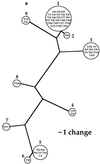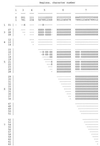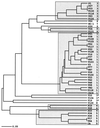Infrequent genetic exchange and recombination in the mitochondrial genome of Candida albicans
- PMID: 11208783
- PMCID: PMC94952
- DOI: 10.1128/JB.183.3.865-872.2001
Infrequent genetic exchange and recombination in the mitochondrial genome of Candida albicans
Abstract
Previous analyses of diploid nuclear genotypes have concluded that recombination has occurred in populations of the yeast Candida albicans. To address the possibilities of clonality and recombination in an effectively haploid genome, we sequenced seven regions of mitochondrial DNA (mtDNA) in 45 strains of C. albicans from human immunodeficiency virus-positive patients in Toronto, Canada, and 3 standard reference isolates of C. albicans, CA, CAI4, and WO-1. Among a total of 2,553 nucleotides in the seven regions, 62 polymorphic nucleotide sites and seven indels defined nine distinct mtDNA haplotypes among the 48 strains. Five of these haplotypes occurred in more than one strain, indicating clonal proliferation of mtDNA. Phylogenetic analysis of mtDNA haplotypes resulted in one most-parsimonious tree. Most of the nucleotide sites undergoing parallel change in this tree were clustered in blocks that corresponded to sequenced regions. Because of the existence of these blocks, the apparent homoplasy can be attributed to infrequent, past genetic exchange and recombination between individuals and cannot be attributed to parallel mutation. Among strains sharing the same mtDNA haplotypes, multilocus nuclear genotypes were more similar than expected from a random comparison of nuclear DNA genotypes, suggesting that clonal proliferation of the mitochondrial genome was accompanied by clonal proliferation of the nuclear genome.
Figures





References
-
- Anderson J B, Kohn L M. Genotyping, gene genealogies, and genomics bring fungal population genetics above ground. Trends Ecol Evol. 1998;13:444–449. - PubMed
-
- Awadalla P, Eyre-Walker A, Smith J M. Linkage disequilibrium and recombination in hominid mitochondrial DNA. Science. 1999;286:2524–2525. - PubMed
Publication types
MeSH terms
Substances
LinkOut - more resources
Full Text Sources
Molecular Biology Databases
Miscellaneous

